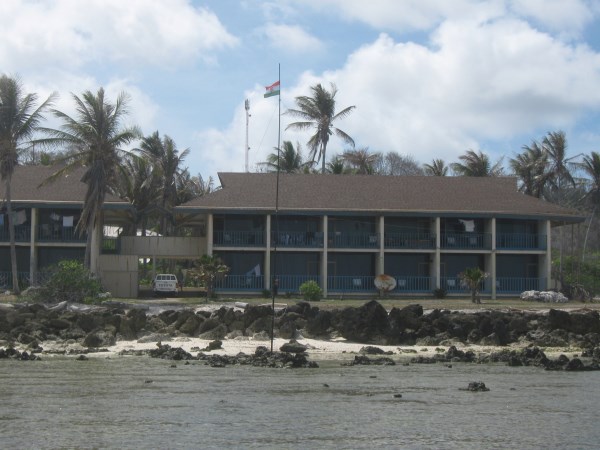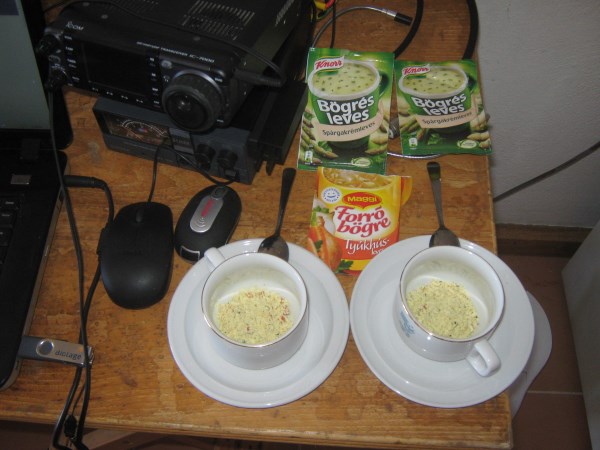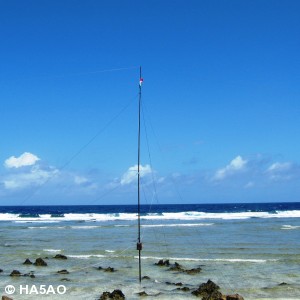One month on an out of the way island that’s really way-out...
(HA5AO and HA5UK)
- Keep it simple! –
Early 2011 (after our successful YJ0HA-Vanuatu trip) we decided to strike the chords again and after some research voted for another Pacific tour in autumn with a target this time of Tuvalu, Banaba, West Kiribati and Fiji with primary focus on the first two. Lots of investigation led us to understand that landing at Banaba is not an ordinary issue—we would have to hold the landing permission of 'The Council of Elders' besides the allowance of Kiribati Government. This 'Council' (they live far from Banaba) was difficult to connect with so we ran out of time when finally they accepted our plan, so we had to postpone the trip to next January. Meanwhile we encountered some other troubles. The air flight between Fiji and Tarawa was temporarily suspended and the nationwide freshwater crisis on Tuvalu resulted in an extreme limitation on checked baggage and moved water to being a top priority cargo on the planes
. That would not have made any sense to go to Tuvalu as the only target with an allowance of only a carry-on package. We are considered as "backpackers" compared to the huge DXpeditions, but with that light setup limited to a total of 30 kg we couldn't get close to our goal. While there wasn't any 'B plan' yet, we didn't want to cancel or postpone our trip again. We had prepared and set our personal life for being off for a month and decided to change our destination all of a sudden. Thus we voted on Nauru, marked as one of the most wanted places in the Central Pacific by DXCC wish-lists (far better ranked than Tuvalu or Kiribati as it turns out).
A new battle begun: we had to get air ticket in a very short time. Nauru has it’s own airline being not part of One World not any other airline alliances which means no contact to any agency, thus one have to buy and pay ticket (if there’s any) right online without any reservation or booking possibility.
All visitors to Nauru have to hold visa to get that air ticket. The visa moreover is tied up for valid air ticket and confirmed accommodation booking. Tricky, isn’t it? That is like the “Catch-22”. Besides it took us weeks of investigation to gain a useful contact on visa issue which was very hard to come by. It seemed we won’t make those out within our limited time, when - just like in a fairy tale - found a very helpful lady at UK Honorary Consulate who helped us to solve this vicious circle.
So we were ready and happy to set off on 6th of January with some 60kg of baggage, including a long ski-bag holding poles, antenna accessories and all other things we could just crammed into that. Surprisingly, at the Budapest Airport they found it not only oversized but also considered over the weight limit according to the airline regulatation from Frankfurt to Brisbane. No mercy – we had to get rid of most of our personal belongings in order to keep all radio-stuff with us. We bought our needs again in Brisbane after 40 hours of flying (including transfer delays in Frankfurt and Hong Kong).
Bad surprises shocked us when checked the ski-bag, found it open and the Steppir EHU – the house and motor of the vertical was lost. Our claim was not effective, only a record was drawn. The flight took us another 6 hours from Australia to land in Nauru with a stopover in Solomon.
 Nauru from the airNauru (named Pleasant Island by the first European whaler) is the smallest republic in the world with a sole island of 21 square km, and the second less populated with some 9000 residents (including foreign workers). Besides, I think it’s the strangest place I’ve ever been or would ever be. It’s history and presence - including geography, economy, sociology, or just its life-style - strangely impressive, but it’s not part of this article, as can’t tell it short. Briefly: It was a real Pacific-paradise 100 years ago with reasonable population who maintained theirself by the Nature.
Nauru from the airNauru (named Pleasant Island by the first European whaler) is the smallest republic in the world with a sole island of 21 square km, and the second less populated with some 9000 residents (including foreign workers). Besides, I think it’s the strangest place I’ve ever been or would ever be. It’s history and presence - including geography, economy, sociology, or just its life-style - strangely impressive, but it’s not part of this article, as can’t tell it short. Briefly: It was a real Pacific-paradise 100 years ago with reasonable population who maintained theirself by the Nature.
Then one found the island the richest land in phosphate. Mining begun and changed all and everything. Meanwhile, they got independence, and during the last four decades, they were the richest then became the poorest branch in the world. Today, no one can tell their future, but it does not seem like a prosperous one…There are 2 hotels in Nauru. Both are pretty old from the ’golden age of sixties’. They don’t count on tourists as there is no tourism at all. One of the hotels is on the west; the other is on south-east coast.While the hardest job is to reach Europe from there, so the most important argument was to consider the take off. During November and December we found that most stations from Zone 31 and 32 came from long path. Also in January the south hemisphere of the globe exposed all day by sun, while north part of the globe is in dark. LP seemed benefit for 20 meters and above, lower bands were still a questionmark.
 Menen HotelOn the other hand, our simple vertical antennas are more effective if it is setting up right in the ocean, what needs special requirements for the accommodation. So we voted on the Hotel Menen on the south-east coast. We booked a ground floor room, with reasonable space and a balcony looked right east, just about 20 meters from the salt water. Our first duty was to get the ham licence. The telecom office can be find in the airport terminal building, where Mr Appi approved our activity immediately, confirmed the call sign and promised the licence to issued quite soon. Nevertheless, he was not in a hurry, received the paper weeks later, so we were not able to complete LoTW certification until the last days of operation.
Menen HotelOn the other hand, our simple vertical antennas are more effective if it is setting up right in the ocean, what needs special requirements for the accommodation. So we voted on the Hotel Menen on the south-east coast. We booked a ground floor room, with reasonable space and a balcony looked right east, just about 20 meters from the salt water. Our first duty was to get the ham licence. The telecom office can be find in the airport terminal building, where Mr Appi approved our activity immediately, confirmed the call sign and promised the licence to issued quite soon. Nevertheless, he was not in a hurry, received the paper weeks later, so we were not able to complete LoTW certification until the last days of operation.
 Antenna set up at low tideNext job was setting the station up.
Antenna set up at low tideNext job was setting the station up.
The system was similar to the previous one we used at YJ0HA. Special light weight base was made to hold the 12m spider-pole in the water. The pole hosted two antennas: a triangle tied to the far guy rope for the upper bands and a T-shape wire for 80 and 160m. Both aerial led to the SGC 235 automatic tuner across a switching relay. The box with additional coil and capacitor was also clamped.
We previously modified the coupler according to the suggestion of TX3A team to make it to tolerate and dissipate higher levels of voltage and tune wider range especially on the top band. Four twisted wires ran down to each base-leg from the coupler, resulting a capacitive balance of the grounding component in order to reduce reactance of the coupler as an elemental part of it. It was mandatory because both vertical wires was low in impedance, yet we wanted the main current to work mostly on them, instead of any other part of the serial system of the cable and ground/coupler. 50 m of RG58 coax and a tuner cable ran to the hotel room secured accurate against damage. We could not set up the BigIr vertical for second station because of the lost motor. As a chance we threw a spare wire up on a palm tree, making a long wire, a kind of inverted L. It was not an effective solution so we were working only one station most of the  Pista, HA5AOtime.Two IC-7000's with Mikrokeyer II modems by Microham served us very well,. The HL 1.1 (Tokyo-Hy-Power) SS amp gave 500 Watts out. There was reliable power- around the island so our 7/24 supply was benefit which is not so common on the Pacific area. Our daily job contained antenna maintenance, checking, replacing ropes, cleaning contacts, and switching antennas manually as the switching relay installed into the coupler interfered with the high voltage of the matching system.
Pista, HA5AOtime.Two IC-7000's with Mikrokeyer II modems by Microham served us very well,. The HL 1.1 (Tokyo-Hy-Power) SS amp gave 500 Watts out. There was reliable power- around the island so our 7/24 supply was benefit which is not so common on the Pacific area. Our daily job contained antenna maintenance, checking, replacing ropes, cleaning contacts, and switching antennas manually as the switching relay installed into the coupler interfered with the high voltage of the matching system.
 George, HA5UKOn the 11th of Jan, after one and a half days of our arrival, the station was ready and we started to work eagerly. After a couple of CQ the band got full with live – huge pileup grew and lasted one month.
George, HA5UKOn the 11th of Jan, after one and a half days of our arrival, the station was ready and we started to work eagerly. After a couple of CQ the band got full with live – huge pileup grew and lasted one month.
We couldn’t enjoy the first pleasure too long anyhow.  UP-UP-UPThe antenna system was set up at low-tide, but we didn’t have experience such an open ocean. It was not a lagoon or bay. The closest land was about 13000 km far from there. When the high-tide was coming we recognised how high and rough the water and waves can be. The coupler and connectors at 2 meters high on the pole were covered by every wave. Even if it was more or less water resistant, the salty water frequently erased reception, and made shortcut on transmition. Next day the pole was laid down and the coupler was moved higher. We played that game a day after too, so it got up to 3m on the pole. Please note we could approach the pole safe only twice a day (once at daytimes, once at nights) as big coral rocks around were quite dangerous even in moderate water-level of 1m or so.
UP-UP-UPThe antenna system was set up at low-tide, but we didn’t have experience such an open ocean. It was not a lagoon or bay. The closest land was about 13000 km far from there. When the high-tide was coming we recognised how high and rough the water and waves can be. The coupler and connectors at 2 meters high on the pole were covered by every wave. Even if it was more or less water resistant, the salty water frequently erased reception, and made shortcut on transmition. Next day the pole was laid down and the coupler was moved higher. We played that game a day after too, so it got up to 3m on the pole. Please note we could approach the pole safe only twice a day (once at daytimes, once at nights) as big coral rocks around were quite dangerous even in moderate water-level of 1m or so.
High tide video
(It takes 10-15 sec to load)
Asia, Oceania and USA were loud from the first time, but we were not lucky with Eu in the first 6 days, signals were low and fluttered. Also we suffered the equatorial noise on the low bands. Fortunately this bad noise disappeared after a week, so we managed to work many station on 80m ever after, from every continent.
The triangle vertical performed amazing again with pretty low radiation angle and in spite of the poor condx (low SFI, high A indexes, magnetic storms). During mornings USA and JA was copied well from 17-10m, and EU was a daily routine on 20 and 17m every evening, always LP. Our good rate was reduced with frequently trying 15, 12, and 10m so we didn’t miss the rare EU-openings on upper bands.
There was a big demand for 160m. It’s always a hard job, and seldom encountered reasonable propagation though kept trying many sunset and night time. We were happy to complete 444 QSO’s on top band including some EU. 160 was not our main goal so we asked patience from the parties because of the lack of any receiving antenna, being aware of the low rate, but really tried to do the best. Many reported anyway to be happy with a new one in the log.
Many thanks to AA7JV (TX3A) for modelling our low band T-vertical for us. It is easy to transport and install. We enjoyed this new experience, which is motivating us for paying more attention to the top band operation next time.
We spent the first week on CW, but focused also on RTTY and SSB afterward, and pleased to make some PSK and SSTV QSO’s too.

 Dining was complicated. There is only one shop on the island to buy water and beers. Some uninviting china canteen can be found around, also a Chinese guy opened a restaurant right in the hotel, but cooking was surely not his profession. The cutie barmaid was kind but we never got real culinary treat.
Dining was complicated. There is only one shop on the island to buy water and beers. Some uninviting china canteen can be found around, also a Chinese guy opened a restaurant right in the hotel, but cooking was surely not his profession. The cutie barmaid was kind but we never got real culinary treat.
 The instant soups we carried from home gave daily highlight while in stock. We had one meal per day and it was enough under that climate and busy operation anyway.
The instant soups we carried from home gave daily highlight while in stock. We had one meal per day and it was enough under that climate and busy operation anyway.
 The people around seemed to be interested in our activity, but seemingly they didn’t really catch on that. The Hotel Board of Directors- kindly invited us to give a presentation on their sit to explain what an earth we were doing there. They liked what we had talked about and revealed that some 30 years ago there had been active amateur radio club with 8 members in Nauru. The only known and licensed HAM today is Robin, C21RK. We met ,him but he is away from radio and lack of any equipment for decades. Also talked with educated people who showed some interest for ham radio operation. We not only showed them our station, but we were talking about the operation, the technical basics of radio waves and propagation. On departing we left the pole, cables, wires, etc. for them.
The people around seemed to be interested in our activity, but seemingly they didn’t really catch on that. The Hotel Board of Directors- kindly invited us to give a presentation on their sit to explain what an earth we were doing there. They liked what we had talked about and revealed that some 30 years ago there had been active amateur radio club with 8 members in Nauru. The only known and licensed HAM today is Robin, C21RK. We met ,him but he is away from radio and lack of any equipment for decades. Also talked with educated people who showed some interest for ham radio operation. We not only showed them our station, but we were talking about the operation, the technical basics of radio waves and propagation. On departing we left the pole, cables, wires, etc. for them.
Making a ’one station-two men’ operation we topped our former goal: made more than 32000 contacts, 8000 EU from that, and besides the huge NA and AS activity we logged many SA and OC.
We would like to say many thanks for all the calls and interests worldwide. for the support from the corporate sponsors, DX Clubs and Foundations and for the support from individuals to making our trip possible and not least Nauru, where we could spend an unforgettable month.

Pista, ha5ao and George, ha5uk




